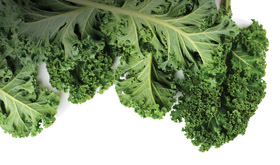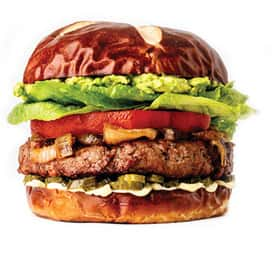Veggie Wars
 Getting your kids to eat vegetables doesn’t have to be a battle, according to nutrition expert Richard Rosenkranz , an associate professor at Kansas State University. The key is to start early, and it doesn’t hurt for moms to start blazing the trail to healthy eating during pregnancy. Research shows that taste preferences are being shaped in the womb, and pregnant women who eat more foods with bitter polyphenolics, such as kale and Brussels sprouts, have children who are more receptive to them when they try them for the first time.
Getting your kids to eat vegetables doesn’t have to be a battle, according to nutrition expert Richard Rosenkranz , an associate professor at Kansas State University. The key is to start early, and it doesn’t hurt for moms to start blazing the trail to healthy eating during pregnancy. Research shows that taste preferences are being shaped in the womb, and pregnant women who eat more foods with bitter polyphenolics, such as kale and Brussels sprouts, have children who are more receptive to them when they try them for the first time.
What’s more, babies as young as six months take cues from their parents. If you’re not eating vegetables, chances are your children won’t either. Rosenkranz suggests parents take advantage of watching eyes by eating vegetables similar to the ones served to babies such as corn and carrots since people of all ages tend to prefer sweeter foods. He also suggests involving young children in cooking and food preparation as early as kindergarten and increasing their roles in the kitchen as they grow.
As for teenagers, vegetable consumption tends to decrease, so easy access is key. Put out a veggie platter with dip for after-school snacks, or leave grab-and-go vegetables in the fridge.
www.sciencedaily.com
Making the Impossible, Possible
 Looking for a delicious alternative to red meat? The Impossible Burger’s veggie patty is as close as it comes to a tasty and juicy burger. On a mission to make the global food system more sustainable, Silicon Valley startup, Impossible Foods has developed a 100 percent plant based burger that you can really sink your teeth into. The Impossible Burger is currently served at three restaurants in San Francisco: Cockscomb, Jardiniére and Public House. The plant-based burger delivers bioavailable protein and iron and has no cholesterol, hormones or antibiotics.
Looking for a delicious alternative to red meat? The Impossible Burger’s veggie patty is as close as it comes to a tasty and juicy burger. On a mission to make the global food system more sustainable, Silicon Valley startup, Impossible Foods has developed a 100 percent plant based burger that you can really sink your teeth into. The Impossible Burger is currently served at three restaurants in San Francisco: Cockscomb, Jardiniére and Public House. The plant-based burger delivers bioavailable protein and iron and has no cholesterol, hormones or antibiotics.
Compared to beef, the Impossible Burger uses 95 percent less land, 74 percent less water and creates 87 percent less greenhouse gas emissions. It’s also conserving our planet, one burger at a time. Eating one quarter-pound Impossible Burger saves the water equivalent of a 10-minute shower and spares 75 square feet of land for wildlife.
Why so meaty? Impossible Burger adds heme to the mix. This iron-containing compound contributes to the characteristic color and taste of meat, and it catalyzes other flavors when meat is cooked.
The main health advantage a non-meat burger has over a regular beef burger, is the avoidance of health risks associated with red meat. High in saturated fat, red meat can raise cholesterol levels increasing the risk of heart disease. While the Impossible burger is still higher in sodium, as an occasional indulgence, it could benefit the environment and the body at the same time.
According to the manager at Cockscomb in San Francisco, they sell up to 400 burgers in a busy week. The bloodiness from the heme and coconut oil fats produce a real meat burger like consistency that appeals to both vegans and carnivores. “It’s great for the vegans who love satisfying that meat craving. Meat eaters love it because of the positive impact it has on the environment,” he says. “It’s leagues ahead of other vegetarian meat options.”
www.impossiblefoods.com
Load Up On Cruciferous
Kale is the star these days as the most popular, leafy green cruciferous vegetable, but there are plenty of other options such as arugula, bok choy, broccoli, Brussels sprouts, cauliflower, cabbage and more. And these rival kale in healthfulness.
Cruciferous vegetables are among the most nutritious because they’re rich in several vitamins and minerals, plus they contain disease-fighting compounds. What’s more, they’re the most common dietary sources of glucosinolates, which are natural chemicals that give vegetables their pungent flavor and break down into cancer-protecting compounds.
A study in the Annals of Oncology found that eating just one serving per week of cruciferous vegetables, lowered the risks of breast, colon, kidney and other cancers. Each type of vegetable has different anticancer compounds, so it’s best to eat a variety.
Source: www.consumerreports.com



